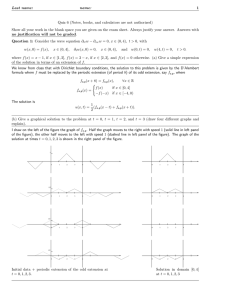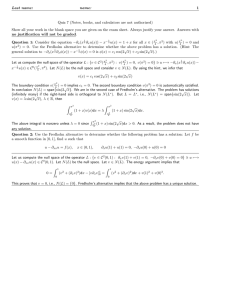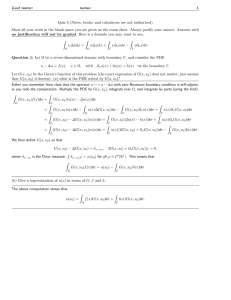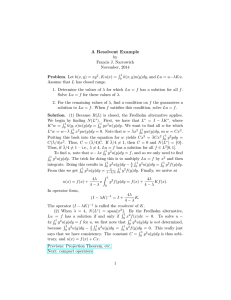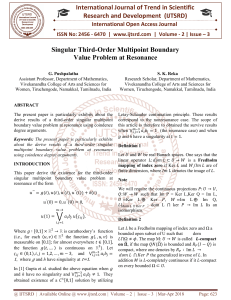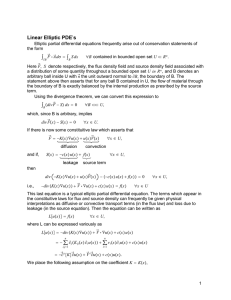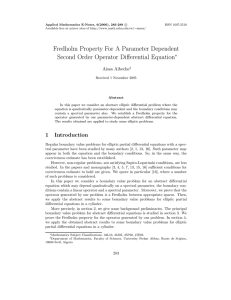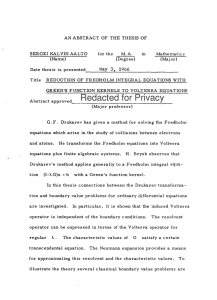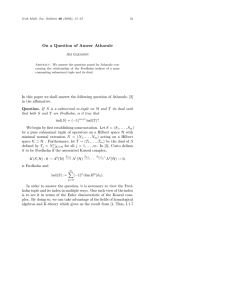Last name: name: 1 Quiz 7 (Notes, books, and calculators are not authorized)
advertisement
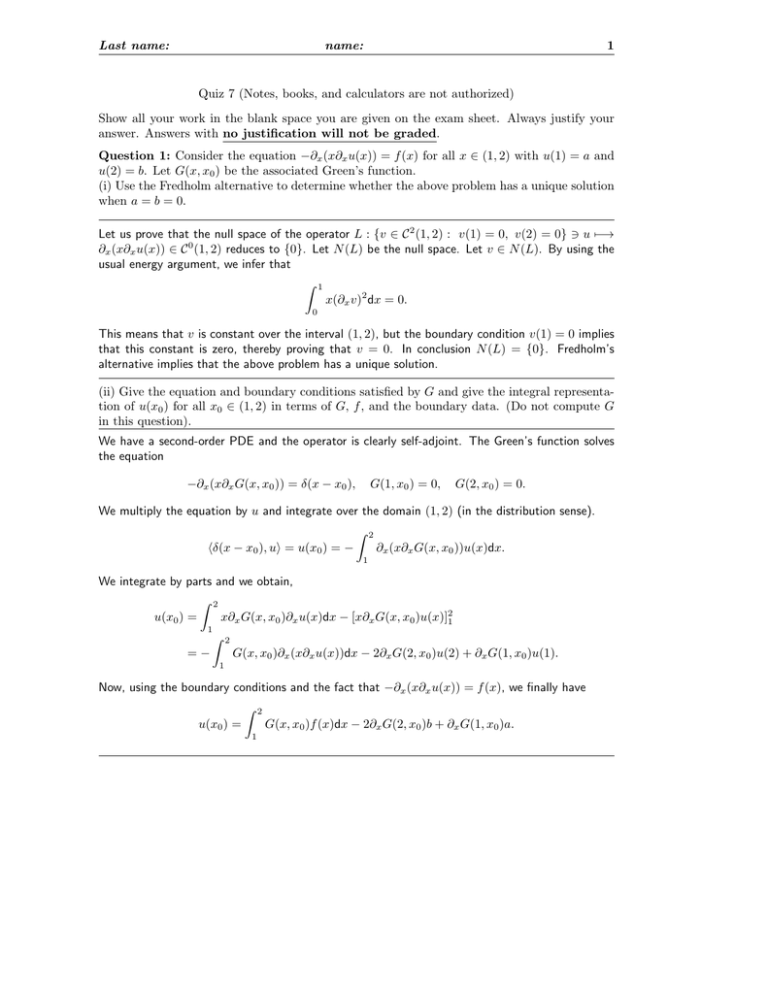
Last name:
name:
1
Quiz 7 (Notes, books, and calculators are not authorized)
Show all your work in the blank space you are given on the exam sheet. Always justify your
answer. Answers with no justification will not be graded.
Question 1: Consider the equation −∂x (x∂x u(x)) = f (x) for all x ∈ (1, 2) with u(1) = a and
u(2) = b. Let G(x, x0 ) be the associated Green’s function.
(i) Use the Fredholm alternative to determine whether the above problem has a unique solution
when a = b = 0.
Let us prove that the null space of the operator L : {v ∈ C 2 (1, 2) : v(1) = 0, v(2) = 0} 3 u 7−→
∂x (x∂x u(x)) ∈ C 0 (1, 2) reduces to {0}. Let N (L) be the null space. Let v ∈ N (L). By using the
usual energy argument, we infer that
Z 1
x(∂x v)2 dx = 0.
0
This means that v is constant over the interval (1, 2), but the boundary condition v(1) = 0 implies
that this constant is zero, thereby proving that v = 0. In conclusion N (L) = {0}. Fredholm’s
alternative implies that the above problem has a unique solution.
(ii) Give the equation and boundary conditions satisfied by G and give the integral representation of u(x0 ) for all x0 ∈ (1, 2) in terms of G, f , and the boundary data. (Do not compute G
in this question).
We have a second-order PDE and the operator is clearly self-adjoint. The Green’s function solves
the equation
−∂x (x∂x G(x, x0 )) = δ(x − x0 ),
G(1, x0 ) = 0,
G(2, x0 ) = 0.
We multiply the equation by u and integrate over the domain (1, 2) (in the distribution sense).
Z
hδ(x − x0 ), ui = u(x0 ) = −
2
∂x (x∂x G(x, x0 ))u(x)dx.
1
We integrate by parts and we obtain,
Z 2
u(x0 ) =
x∂x G(x, x0 )∂x u(x)dx − [x∂x G(x, x0 )u(x)]21
1
Z
=−
2
G(x, x0 )∂x (x∂x u(x))dx − 2∂x G(2, x0 )u(2) + ∂x G(1, x0 )u(1).
1
Now, using the boundary conditions and the fact that −∂x (x∂x u(x)) = f (x), we finally have
Z
2
G(x, x0 )f (x)dx − 2∂x G(2, x0 )b + ∂x G(1, x0 )a.
u(x0 ) =
1
2
Quiz 7, October 31, 2013
(iii) Compute G(x, x0 ) for all x, x0 ∈ (1, 2).
For all x 6= x0 we have
−∂x (x∂x G(x, x0 )) = 0.
The solution is
(
G(x, x0 ) =
a log(x) + b if 1 < x < x0
c log(x) + d if x0 < x < 2
The boundary conditions give b = 0 and d = −c log(2); as a result,
(
a log(x)
if 1 < x < x0
G(x, x0 ) =
c log(x/2) if x0 < x < 2
G must be continuous at x0 ,
a log(x0 ) = c log(x0 ) − c log(2)
and must satisfy the gap condition
Z x0 +
−
∂x (x∂x G(x, x0 ))dx = 1,
∀ > 0.
x0 −
This gives
−
−x0 ∂x G(x+
0 , x0 ) − G(x0 , x0 ) = 1
c
a
−x0 ( − ) = 1
x0
x0
This gives
a − c = 1.
In conclusion log(x0 ) = −c log 2 and
c = − log(x0 )/ log(2),
This means
a = 1 − log(x0 )/ log(2) = log(2/x0 )/ log(2).
( log(2/x
G(x, x0 ) =
0)
log(2) log(x)
log(x0 )
log(2) log(2/x)
if 1 < x < x0
if x0 < x < 2
Question 2: Use the Fredholm alternative to determine whether the following problem has a
unique solution: Let f be a smooth function in [0, 1], find u such that
u − ∂xx u = f (x),
x ∈ (0, 1),
∂x u(1) + u(1) = 0, −∂x u(0) + u(0) = 0
Fully justify your answer.
Let us compute the null space of the operator L : {v ∈ C 2 (0, 1) : ∂x v(1) + v(1) = 0, −∂x v(0) +
v(0) = 0} 3 u 7−→ u(x) − ∂xx u(x) ∈ C 0 (0, 1). Let N (L) be the null space. Let v ∈ N (L). The
energy argument implies that
Z 1
Z 1
0=
(v 2 + (∂x v)2 )dx − [v∂x v]10 =
(v 2 + (∂x v)2 )dx + v(1)2 + v(0)2 .
0
0
This proves that v = 0, i.e., N (L) = {0}. Fredholm’s alternative implies that the above problem
has a unique solution.

